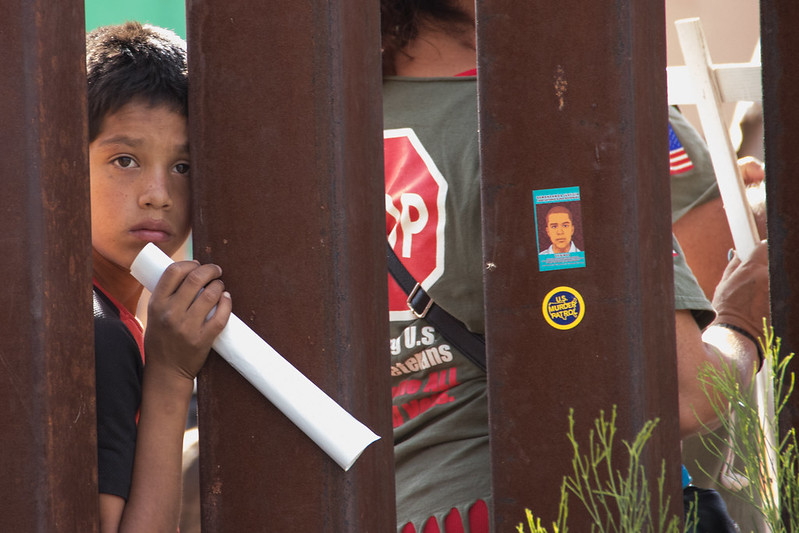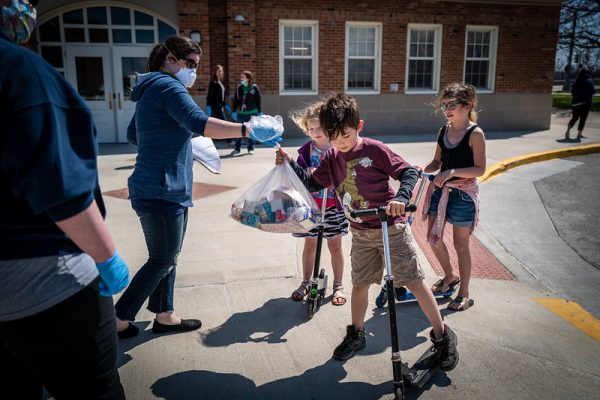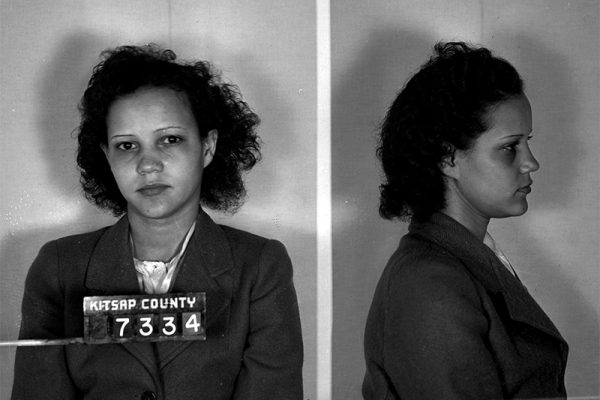Taking Children: A History of American Terror
Laura Briggs
University of California Press, $24.95 (cloth)
Given the innumerable failures and humiliations that have marked Donald Trump’s presidency, one might be forgiven for forgetting the administration’s unconscionable “zero tolerance” immigration enforcement policy. First “piloted” in 2017 before its formal launch in the spring of 2018, the program required the prosecution of all migrants crossing the border with Mexico without authorization—including asylum seekers—and ordered U.S. authorities to split up migrant families apprehended at the border.
Briggs’s study encourages us to imagine the family, the child, and social reproduction as key battlegrounds in a long conflict against people of color.
According to the U.S. Customs and Border Patrol, officials separated 2,342 children from 2,206 adults between May 5 and June 9, 2018, and placed these minors in Office of Refugee Resettlement shelters and other facilities peppered throughout the country. The conditions at one of these facilities, an old warehouse in McAllen, Texas, generated particularly intense scorn, as news media outlets spotlighted the cages in which Border Patrol authorities held children as young as two years old. One migrant rights advocate with the Women’s Refugee Commission, after touring the McAllen facility, told the Associated Press that she spoke with a sixteen-year-old who had tended to a young girl for three days. “She had to teach other kids in the cell to change her diaper,” the advocate reported in dismay.
The sordid saga of Trump’s family separation policy lays the foundation for gender and sexuality studies scholar Laura Briggs’s new book Taking Children: A History of American Terror, which provides a genealogy of “taking children” in the American past. Rather than a historical aberration, Briggs argues, Trump’s policy built upon earlier acts of dispossession directed at black, Native, Latin American, refugee, and other historically subjugated children and families. “There is in this hemisphere a powerful racialized haunting,” Briggs writes, “generation upon generation of children who have lost parents, and parents, children.” To prove this claim (and she does), Briggs takes a sweeping approach, looking at contexts in which taking children has served as a “tactic of terror.” She travels from the slaveocracy of the American South to Indian boarding schools, and from (U.S.-backed) regimes of torture and kidnapping in Argentina, El Salvador, and Guatemala to the daunting deportation machinery developed by Presidents Bill Clinton, George W. Bush, Barack Obama, and now, Trump. Across the vast expanse of U.S. history and with stunning frequency, Briggs shows, U.S. government forces—alongside state and local entities—have stolen children from mothers, fathers, families, and communities deemed deviant and inimical to the idealized American family form.
This is a formidable book, one that cuts against the Trump exceptionalism that suffuses much mainstream liberal discourse. With its focus on children and the normative dual-parent, pronatal family long prized by the U.S. government, Taking Children also adds a new wrinkle to recent scholarly discussions concerning what Nikhil Pal Singh calls “America’s long war.” Singh and other historians such as Michael Sherry have employed the capacious frame of war to describe campaigns waged by the U.S. government against communities of color, especially over the past half-century. “War,” Sherry asserts, “gearing up for it, waging it, imagining many things in terms of it (‘war on drugs’)—is what the nation does.”
U.S. government forces—alongside state and local entities—have stolen children from mothers, fathers, families, and communities deemed deviant and inimical to the idealized American family form.
For Singh, a “racial nationalism” has served as the engine behind America’s “inner” and “outer” wars, from extirpative campaigns to “tame” the “savage” frontier, to the legal and extralegal enforcement of Jim Crow and his siblings, to Lyndon Baines Johnson’s “war within our own boundaries” concentrating on urban environments populated by restive people of color. Singh also claims that the “inner” and “outer” wars fell into increasing alignment during the latter parts of the twentieth century and the “war on terror” of the twenty-first. In the wake of the 1992 Los Angeles uprising, the disastrous drug war, and the federal law enforcement mismanagement of incidents at Ruby Ridge and Waco, the much-ballyhooed (and long brewing) “militarization” of police forces reached a fever pitch, just as welfare “reform” in 1996 further crystallized a regime of criminalizing poverty and “disciplining the poor,” and just as “border enforcement” moved under the aegis of “homeland security” after 9/11.
While Briggs doesn’t consistently deploy the framework of war in Taking Children, her study encourages us to imagine the family, the child, and social reproduction as key battlegrounds in this long conflict against people of color. The government’s enduring yet evolving project of family formation—the creation of self-sufficient, two-parent, homeowning, pronatal families—has relied not only on “carrots” like tax incentives and government-backed mortgages but also on “sticks” such as hyperpolicing, incarceration, and (as Briggs reminds us) the forcible seizure of children from “unfit” or “incorrigible” (or simply poor or houseless) black and brown parents. This is war.
“Taking children has been a strategy for terrorizing people for centuries,” Briggs notes in her introduction. “There is a reason why ‘forcibly transferring children of [one] group to another group’ is part of international law’s definition of genocide.” Indeed, the loss of a child surely ranks among the most traumatic experiences that an individual might endure, and it also serves as a foremost mechanism through which a policymaker or other agent of the state might interrupt processes of reproduction.
The historical roots of this practice run deep. Family separation proved central to the enterprise of racialized chattel slavery and to the tactics of moral suasion employed by abolitionists. During congressional debates over the Thirteenth Amendment, for instance, Iowa Senator James Harlan lamented slavery’s “abolition practically of the parental relation,” which thereby deprived “the offspring of the care and attention of his parents, severing a relation which is universally cited as the emblem of the relation sustained by the Creator to the human family.” Images like the one captioned “The Separation of the Mother and Child” in Harriet Beecher Stowe’s Uncle Tom’s Cabin “brought the moral crisis of slavery to the fore and enabled abolitionists to demand its end in the context of the Civil War,” Briggs writes.
“There is in this hemisphere a powerful racialized haunting,” Briggs writes, “generation upon generation of children who have lost parents, and parents, children.”
Even with the formal, legal destruction of slavery, though, the separation of black children and parents continued. In the Reconstruction, Gilded Age, and Progressive eras, black children deemed “orphans” often found themselves ensnared in coercive apprenticeships or in prisons. Chain gangs and other brutal forms of state-sanctioned punishment frequently snatched up African American parents, as well—not only around the turn of the century, but also well into the twentieth. The early waves of the Great Migration delivered many black families to the West and industrial North, where they had hoped to escape “the regimes of sharecropping, the chain gang, and child taking,” explains Briggs. Yet these migrants (and those who remained in the South) soon encountered a new system of child taking rooted in the consolidating U.S. welfare state and in resistance to the burgeoning black freedom movement.
Launched through the 1935 Social Security Act, the Aid to Dependent Children program (later Aid to Families with Dependent Children) provided modest assistance to poor mothers with children. Long a lightning rod for political controversy—critics contended that ADC/AFDC rewarded promiscuity, discouraged family formation, and promoted fraud—the program attracted specific attention from white supremacist politicos during what Bayard Rustin called the “classical” phase of the civil rights movement, 1954–1965. Briggs provocatively examines the intersections between anti-welfarist and segregationist politicking. As black activists and their white allies petitioned for voting rights, school desegregation, and the fall of the Jim Crow order in the 1950s and 1960s South, white state officials trained their ire on “welfare mothers” who “failed to keep a suitable home” and raised “illegitimate” children, Briggs explains. Florida, Tennessee, and other states encouraged mothers whose homes had been deemed unsuitable and their children illegitimate “to relinquish their children to relatives” or risk losing them to the foster care system. In this respect, vindictive state governments largely (though not exclusively) reserved their wrath for women of color. In Florida, for example, “state welfare workers challenged the suitability of 13,000 families,” only 9 percent of whom were white, “even though white families made up 39 percent of the total caseload.”
Put another way, white lawmakers and other authorities identified African Americans as an insurrectionary population that threatened the most venerated members of the body politic—specifically white children in public schools. To punish black Mississippians, state officials vilified poor black mothers and children as indolent and “illegitimate,” deprived them of state support, and separated them. (Briggs does not explicitly indicate what sort of mechanisms facilitated the separation of black families, but presumably Mississippi state authorities steered children toward a racist foster care system.) Such child taking should be situated within the violent war waged against civil rights agitation in Mississippi—as evidenced by the Emmett Till lynching, the Freedom Summer murders, Fannie Lou Hamer’s brutalization at the hands of police, and the Medgar Evers assassination—and throughout the United States.
Similar logics have animated what historian Annelise Orleck dubs “the war on the War on Poverty,” which has raged since Lyndon Johnson launched an assault on U.S. poverty in 1964. Near the close of the twentieth century—as racist anxieties regarding “superpredators,” teen pregnancy, “crack babies,” and welfare fraud dominated domestic politics—national politicians targeted Native American and black women through “the criminalization of drug use and drinking” during pregnancy, Briggs explains. In the 1990s conservatives and neoliberals alike sought, as Bill Clinton put it, to “end welfare as we have come to know it.” House Speaker Newt Gingrich, for his part, vowed, Briggs reminds us, to “take the children of welfare mothers and put them in orphanages.” These rhetorical flourishes culminated in the bipartisan Personal Responsibility and Work Opportunity Reconciliation Act (PRWORA) of 1996, which terminated AFDC and replaced it with the less generous, more punitive, and more market-conforming Temporary Assistance for Needy Families (TANF). Lawmakers justified the shift to TANF through the law’s preamble, “a long discourse on sexual morality, illegitimacy, and the virtues of men in the house and heterosexual marriage,” as Briggs characterizes it.
The ideology of neoliberal family values has also betrayed a stunning willingness to deploy state force in the name of fortifying the idealized nuclear family.
As social theorist Melinda Cooper revealed in her book Family Values: Between Neoliberalism and the New Social Conservatism (2017), the white, heteronormative, dual-parent, pronatal family structure on which the modestly redistributive New Deal state rested gave way in the neoliberal era to a more racially egalitarian normative family, a model that also prized superficial equality along lines of sex and sexual orientation. Yet neoliberal “family values” has depended less on state provision and more on the devolution of social responsibility to the normative family unit—through the idiom of personal and household debt, for instance.
The ideology of neoliberal family values has also betrayed a stunning willingness to deploy state force in the name of fortifying the idealized nuclear family. Take, for example, the explosion in the 1990s and 2000s of sex offender registries (which overlook the pervasive threat of sexual abuse within the family household by situating such perils elsewhere). Consider also the intensifying criminalization of child support delinquency and domestic violence in the late twentieth century, the growing enmeshment of carceral and non-carceral tools in the social service and healthcare arenas (such as child protective services), and the hardening deportation regime. These phenomena disproportionately entangle poor and working-class families in the prison-industrial complex and do nothing to rectify the structural, material circumstances out of which their misery erupts.
Briggs deftly reconstructs much of this complex picture, but not all of it. Focusing almost exclusively on racialized populations obscures the ways that state violence looms over and adversely shapes the lives of other Others—from LGBTQIA+ parents and children to poor whites to sex workers—in the present neoliberal permutation of America’s long war. The Prison Policy Initiative and others have established a strong correlation between homelessness and incarceration—especially among youth—and because LGBTQ youth face a heightened risk of homelessness on account of their inability to conform to heteronormative, pronatal expectations, they are overrepresented in the U.S. juvenile justice system. Due in part to the longstanding association of queer folks with sexual “deviance,” LGBTQ youths are also far more likely than those who identify as straight to appear on sex offender registries.
The picture crosses racial lines, as well; poor white families experience traumatic, state-sanctioned disruptions too. Deindustrialization, deunionization, the hollowing out of once-thriving communities, the rise of precarious, degraded service and retail labor, the opioid crisis, and a widespread, toxic, possessive investment in whiteness—all processes unleashed or midwifed by federal, state, and local policy—have triggered in recent years an epidemic of “deaths of despair” among white Americans, especially those in the working class without college degrees.
Addressing the crosscutting dimensions of this pernicious system might open up opportunities for more effective, intersectional resistance.
Sex work, moreover, supposedly poses an existential threat to the idealized American family, and its practitioners face either arrest and incarceration or “rescue” (if they have somehow been “recruited”). According to the Bureau of Justice Statistics, in 2010 an estimated 62,668 arrests were made for “prostitution and commercialized vice.” Punitive, carceral responses to such matters not only deny the agency of sex workers themselves (many of whom find sex work lucrative, rewarding, and even empowering); they destabilize families more than prostitution ever could.
Of course, as the uprisings staged in response to George Floyd’s murder reveal, race remains the key factor determining one’s susceptibility to state violence in our current historical conjuncture. But poverty, precarity, and “perversion” also mark other subjects suspicious and threatening to neoliberal family values and those who live according to its dictates. Hence the crystallization in the past forty years of a “war on sex,” which targets sexual behaviors, identities, and practices inconsonant with the norms and expectations forged and practiced through pronatal marriage (even same-sex marriage, as Briggs illustrated in her 2012 book Somebody’s Children: The Politics of Transracial and Transnational Adoption). While race retains tremendous explanatory and analytical value in discussions of policing, war, and the muscular reinforcement of neoliberal family values, it should not conceal the fact that a third of those incarcerated in juvenile detention facilities are white (far, far below whites’ percentage in the general U.S. population, of course, but not insignificant), or that white children account for 44 percent of those entangled in the U.S. foster care system. Addressing the crosscutting dimensions of this pernicious system might open up opportunities for more effective, intersectional resistance.
None of this diminishes Briggs’s achievement in exposing the ways that black and brown families have confronted an often hostile, militarized state intent on shoring up family values, even if it comes at the cost of terrorizing real families. Her book pushes us to think more deeply about “war as a way of life” (as Sherry puts it) in the United States—and about the primacy of neoliberal family values within that war.







